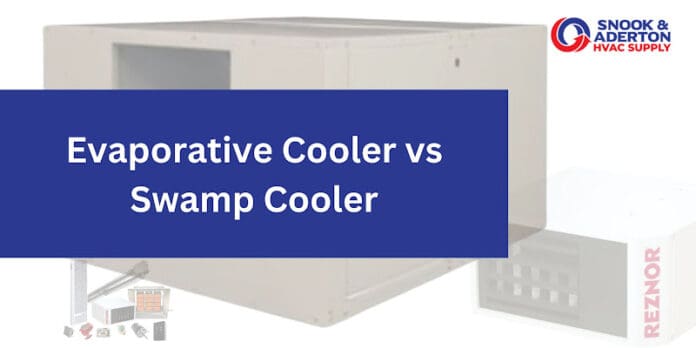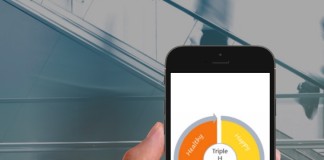When considering cooling options beyond traditional air conditioning, you may hear terms like “evaporative cooler” and “swamp cooler.” These alternative cooling systems have gained popularity as energy-efficient options, particularly in dry climates.
However, confusion often arises regarding whether these are two distinct systems or simply different names for the same technology. This article clarifies the terminology, explains how these coolers work, and helps determine if this cooling solution suits your needs.
As energy costs rise and environmental concerns grow, many homeowners and businesses seek cost-effective cooling strategies that consume less electricity than conventional air conditioning. Understanding evaporative cooling technology’s capabilities, limitations, and ideal applications can help you decide about your climate control options.
Key Takeaways
- Evaporative and swamp coolers are the same technology, with “swamp cooler” being a colloquial term.
- These coolers work by evaporating water to cool incoming air, adding humidity.
- They’re most effective in hot, dry climates with relative humidity below 50%
- According to the Department of Energy, they use up to 75% less energy than traditional air conditioners.
- While less effective than air conditioning, they’re more eco-friendly and cost-efficient.
- Whether upgrading your HVAC system or needing expert advice, explore our full range of products at SnookHVAC to keep your home or business running efficiently. With high-quality evaporative coolers and expert recommendations, you can find the perfect cooling solution for your space.
Evaporative Cooler vs Swamp Cooler: Are They The Same?
Terminology Differences
The short answer is YES. Evaporative coolers and swamp coolers are the same technology. Here’s how the terminology breaks down:
- Evaporative cooler: The technical and industry-standard term for this cooling technology
- Swamp cooler: A colloquial or regional nickname for evaporative coolers, ubiquitous in the southwestern United States
- Desert cooler: Another regional term used in some areas, emphasizing where these units work best
- Wet air cooler: Sometimes used to distinguish from “dry” air conditioning systems
Swamp coolers have become widely used in everyday language, while “evaporative coolers” are more commonly used in technical and marketing materials. Manufacturers prefer the term “evaporative cooler” as it more accurately describes the scientific process and avoids the potentially negative connotations of “swamp.”
Functionality Comparison
Since they are the same technology, there are no functional differences between devices marketed as evaporative coolers versus those called swamp coolers. However, within the category of evaporative cooling, there are different types and configurations:
- Direct evaporative coolers: The standard type where air passes directly through wet pads
- Indirect evaporative coolers: Use a heat exchanger to cool the air without adding humidity
- Two-stage (indirect/direct) coolers: Combine both methods for greater efficiency
- Portable units: Smaller, movable systems for targeted cooling
- Whole-house systems: Larger units designed to cool an entire home
- Down-discharge vs. side-discharge: Refers to the direction in which the cooled air is expelled
While these variations exist, all evaporative or swamp coolers operate on the same basic principle of evaporative cooling.
What Is An Evaporative Cooler?
How It Works
An evaporative cooler operates on a simple scientific principle: When water evaporates, it absorbs heat from the surrounding air, creating a cooling effect. Here’s the step-by-step process of how an evaporative cooler functions:
- A fan draws warm outside air into the unit
- The air passes through water-saturated cooling pads
- As the air moves through these damp pads, water evaporates into the air
- This evaporation process absorbs heat energy from the air
- The resulting cooler, more humid air is then circulated into your living space
- Windows or vents must remain partially open to allow hot air to escape
This process is the same principle that causes your skin to feel cool when perspiration evaporates. Unlike traditional air conditioning, which uses refrigerants and compressors to remove heat, evaporative cooling uses only water and air movement to create a cooling effect.
Key Features
Standard evaporative coolers have several distinctive features:
- Water reservoir: Holds the water that will evaporate to create cooling
- Water pump: Circulates water to keep the cooling pads saturated
- Cooling pads: Usually made of cellulose or other absorbent materials that hold water while allowing air to pass through
- Fan system: It draws air through the cooling pads and into your space
- Water distribution system: Ensures even wetting of the cooling pads
- Housing: Contains all components, often designed for roof, window, or portable installation
- Controls: Regulate fan speed, water flow, and sometimes automatic functions
Modern evaporative coolers may also include features like programmable timers, remote controls, air filters, and water-level indicators. Some advanced models, known as two-stage evaporative coolers, use a heat exchanger to pre-cool the air without adding humidity, followed by a second evaporative cooling stage.
Top 2 Recommended Evaporative Heaters For 2025
Here is a review of the best portable evaporative heaters for commercial uses in 2025
Champion 14/21-SD Evaporative Cooler
The Champion 14/21-SD Evaporative Cooler is a robust cooling solution designed for commercial applications. Its airflow capacity of 14,000 to 21,000 CFM effectively cools large spaces between 4,000 to 10,000 square feet. Constructed with heavy-gauge galvanized steel and a polyester powder-coated finish, this unit ensures durability and resistance to corrosion.
Notably, the cooler operates without ozone-depleting refrigerants, making it an environmentally friendly choice. However, the motor is not included, and the unit requires LTL freight shipping.
Buy if:
- You need a high-capacity cooling system for an ample commercial or industrial space.
- Durability and corrosion resistance are priorities for your installation.
- You prefer an eco-friendly cooling solution without harmful refrigerants.
What I liked:
- The substantial cooling capacity efficiently manages large areas.
- The sturdy construction ensures longevity, even in demanding environments.
- The use of evaporative cooling technology aligns with eco-conscious operational goals.
Champion AD150B Blower Cabinet
The Champion AD150B Blower Cabinet is engineered for commercial cooling, offering a versatile solution for various applications. This down-draft blower cabinet accommodates different motor sizes, allowing customization based on specific airflow requirements.
The cabinet is constructed from heavy-gauge galvanized steel with a polyester powder-coated finish, ensuring durability and resistance to environmental factors. Please note that the motor and wet sections are not included, and the unit must be shipped via LTL freight.
Buy if:
- You require a customizable blower cabinet for a commercial cooling system.
- Durability and resistance to environmental wear are essential for your installation.
- You have specific motor requirements and prefer to select components separately.
What I liked:
- The flexibility to choose motor sizes allows for tailored airflow solutions.
- The robust construction ensures the cabinet withstands rigorous operational conditions.
- The design facilitates easy integration into existing cooling systems.
Advantages Of Evaporative Coolers
-
Energy Efficiency
One of the most significant benefits of evaporative cooling systems is their energy efficiency:
- Use up to 75% less electricity than conventional air conditioners
- Typically consume only 1,500 watts or less, similar to a hair dryer
- Most energy use comes from powering the fan and small water pump
- No energy-intensive compressor or refrigeration cycle
- Can reduce cooling costs by $150-$400 per season compared to air conditioning
According to the U.S. Department of Energy, evaporative coolers cost approximately half as much to install as central air conditioners and use about one-quarter the energy. This efficiency makes them particularly attractive in regions with high electricity rates.
-
Eco-Friendliness
Evaporative coolers offer several environmental advantages:
- Use no refrigerants, which can be potent greenhouse gases
- Consume significantly less electricity, reducing carbon footprint
- Operate with just water as the cooling medium
- Introduce fresh air rather than recirculating indoor air
For environmentally conscious consumers, the simple technology and low resource consumption of evaporative coolers align well with sustainability goals.
-
Cost Effectiveness
Beyond energy savings, evaporative coolers offer financial benefits:
- Lower purchase price: $150-$500 for portable units, $1,000-$2,000 for whole-house systems (versus $3,000-$7,000 for central air conditioning)
- Less expensive installation, often 50% less than central AC
- Reduced monthly utility bills during the cooling season
- More straightforward maintenance that the homeowner can often perform
The combination of lower upfront costs and reduced operating expenses makes evaporative cooling an economically attractive option for many households in suitable climates.
Some Considerations Of Evaporative Coolers
-
Climate Restrictions
The most significant limitation of evaporative coolers is their climate dependency:
- Humidity constraints: Effectiveness decreases dramatically as relative humidity rises above 50%
- Geographic limitations: Primarily effective in dry, arid regions like the American Southwest, parts of Australia, and Middle Eastern countries
- Seasonal restrictions: May become ineffective during monsoon seasons or humid periods
- Temperature limits: Typically can’t cool air below about 65-70°F, regardless of the starting temperature
- Climate change considerations: Some traditionally dry areas are experiencing increasing humidity levels
Evaporative coolers add moisture to humid air in humid climates, such as the southeastern United States or tropical regions, potentially worsening comfort levels.
-
Maintenance Needs
Evaporative coolers require specific maintenance to function correctly:
- Regular pad replacement: Cooling pads typically need replacement every 1-3 seasons
- Water management: Systems must be drained when not in use to prevent stagnation
- Mineral buildup: Hard water can cause scale buildup that must be cleaned
- Winter preparation: Units need to be winterized in colder climates
- Microbial concerns: Without proper maintenance, moist environments can support mold or bacteria growth
- Filter cleaning: Air filters need regular cleaning or replacement
- Spring startup procedure: A specific process to prepare the unit after winter
While these maintenance tasks aren’t necessarily complex, they require consistent attention to ensure efficient operation and prevent potential air quality issues.
Performance of Evaporative Coolers
Portability And Versatility
- Portable units: Typically on wheels, can be moved between rooms or stored when not needed
- Window units: Install in window frames, similar to window air conditioners
- Down-draft systems: Installed on roofs, push cool air down through ceiling vents
- Side-draft systems: Mounted on external walls, push air horizontally into the space
Durability
- Expected lifespan: Typically 15-20 years for well-maintained units
- Component longevity: Motors and pumps generally last 5-10 years
- Cooling pad lifespan: 1-3 years depending on water quality and usage
- Housing durability: Metal housings may corrode over time if not properly maintained
Other Cooling Solutions
Several other approaches may be suitable depending on needs:
- Geothermal cooling: Uses the earth’s stable temperature to cool homes
- Whole-house fans: Pull cool evening air through the home and exhaust hot air through the attic
- Ice cooling: DIY methods using ice and fans for temporary cooling
- Solar reflective roofing: Reduces heat gain from the roof
- Natural ventilation strategies: Using home design to maximize airflow
- Night flushing: Opening windows at night and closing during the day to trap cool air
- Dehumidifiers: Remove moisture without cooling but can improve comfort in humid conditions
These alternatives may be used alone or with other cooling methods for optimal comfort and efficiency.
Final Verdict
Evaporative and swamp coolers are identical technologies; they are different names for the same cooling system. They offer an energy-efficient, environmentally friendly cooling solution that works exceptionally well in hot, dry climates. The Department of Energy estimates they use 75% less electricity than traditional air conditioning, making them a cost-effective option for appropriate regions.
However, their effectiveness is limited by climate conditions. In areas with relative humidity consistently above 50%, their cooling capacity is significantly reduced, making traditional air conditioning a better choice despite higher energy consumption.
Frequently Asked Questions
What is the ideal humidity level for using an evaporative cooler?
Evaporative coolers work best when the relative humidity is below 50%. Their effectiveness diminishes significantly as humidity rises, and they provide little cooling benefit when humidity exceeds 70%.
How much water do evaporative/swamp coolers use?
Water consumption varies by unit size and climate conditions but typically ranges from 3-15 gallons per hour during operation. A medium-sized residential unit might use 7-8 gallons per hour, resulting in approximately 50-60 gallons per day with 8 hours of operation.
Can I use an evaporative cooler in only certain rooms of my house?
Yes, portable or window-mounted evaporative coolers can be used for zone cooling specific areas. However, you’ll still need to provide air outlets (like slightly open windows) in those rooms for proper airflow.
Do evaporative coolers work at night?
Yes, evaporative coolers can work effectively at night, often even better than during the day since relative humidity typically decreases after sunset in many areas. They can be particularly effective for pulling in cooler night air and further reducing its temperature.






